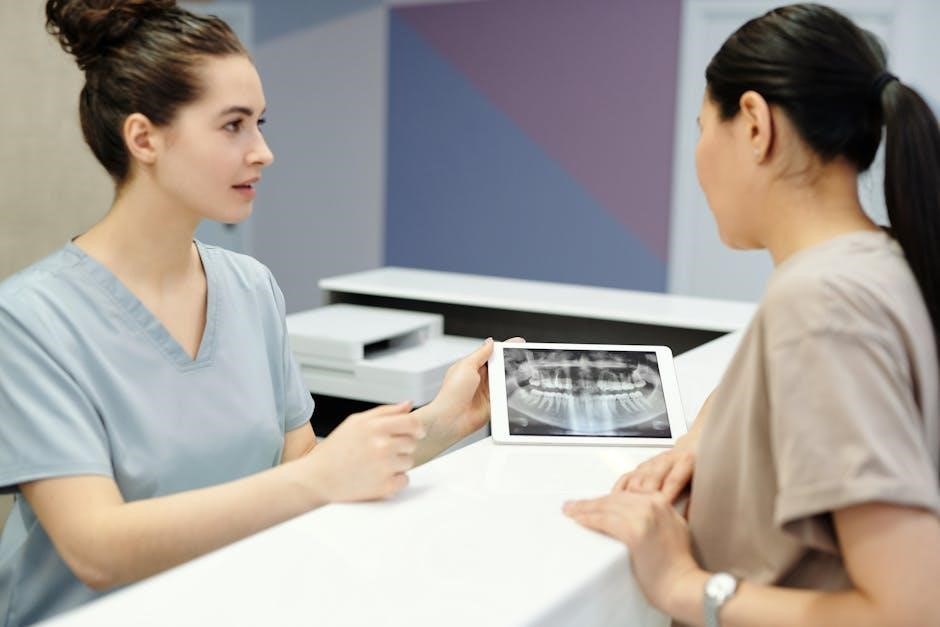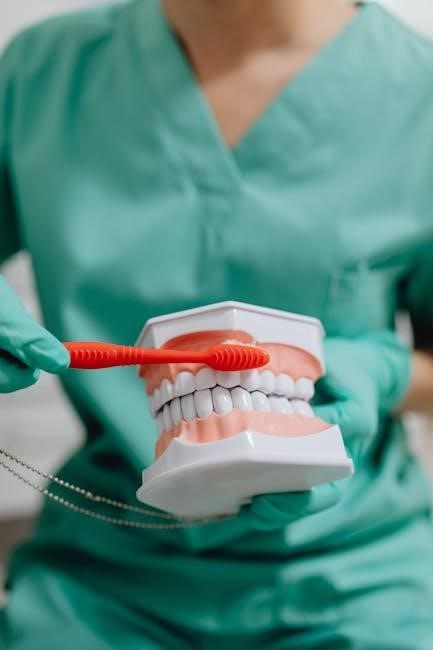
Triazolam, a potent benzodiazepine, is widely used in dentistry to alleviate anxiety and fear during procedures. It induces relaxation, reduces anxiety, and provides amnesic effects, making dental treatments more comfortable for patients. Its rapid onset and short half-life make it ideal for minimizing discomfort and ensuring a smooth experience.
1.1 Overview of Triazolam and Its Use in Dentistry
Triazolam, a benzodiazepine, is commonly used in dentistry for its anxiolytic and sedative properties. It is prescribed to reduce anxiety and fear, enabling patients to undergo dental procedures comfortably. Its rapid onset and short half-life make it ideal for dental sedation, allowing patients to relax without prolonged drowsiness. Triazolam is typically administered orally, providing a calm state while maintaining patient responsiveness during treatment.

1.2 Benefits of Using Triazolam for Dental Anxiety
Triazolam effectively reduces dental anxiety by inducing relaxation and calming the mind. Its amnesic properties help patients forget the procedure, minimizing emotional distress. The rapid onset and short duration ensure patients feel comfortable without prolonged drowsiness. This makes it ideal for anxious individuals, allowing them to undergo necessary treatments with ease and minimal stress, while remaining responsive to the dentist during the procedure.

Pre-Operative Instructions for Triazolam Use
Prior to your dental appointment, avoid eating or drinking for 8 hours. Arrive early, wear loose clothing, and avoid colored nail polish. Bring a companion to accompany you home after the procedure.
2.1 Dosage and Timing of Triazolam Administration
Typically, patients are prescribed one Triazolam tablet, 0.25mg, taken one hour before the dental appointment. In some cases, a second dose may be administered during the procedure if needed. Patients should take the medication on an empty stomach to ensure rapid absorption. It is crucial to follow the dentist’s specific instructions regarding dosage and timing to achieve optimal sedation levels and minimize side effects.

2.2 Necessary Preparations Before the Dental Appointment
Patient preparation is crucial for safe and effective sedation. Fasting for 8 hours prior to the appointment is required, and smoking or consuming alcohol should be avoided. Loose, comfortable clothing is recommended to facilitate monitoring. Patients must arrange for a responsible adult to escort them to and from the office, as driving is prohibited after sedation. Adhering to these guidelines ensures a smooth and safe experience.
2.3 What to Avoid Before Taking Triazolam
Before taking triazolam, patients should avoid alcohol, grapefruit, and caffeine, as these can interact with the medication. Smoking and heavy meals should also be avoided. Patients must not take other medications unless approved by their dentist. Additionally, driving or operating machinery within 24 hours is prohibited. Informing the dentist about all medications and health conditions is essential to ensure safe sedation.

The Dental Procedure Under Triazolam Sedation
During the procedure, patients remain relaxed and calm, often with minimal memory of the treatment. The dentist ensures comfort and safety while performing the necessary work.
3;1 Patient Experience During the Procedure
Patients typically feel deeply relaxed and calm under Triazolam sedation, with reduced anxiety and discomfort. Many report minimal memory of the procedure, creating a stress-free experience.
While drowsy, patients remain responsive to the dentist’s instructions, allowing for effective communication. The sedation ensures a comfortable and peaceful environment, making dental treatments less intimidating and more manageable for anxious individuals.
3.2 Monitoring and Safety Measures
During the procedure, patients are continuously monitored for vital signs, including heart rate and oxygen levels, using devices like a pulse oximeter.
The dental team ensures the patient’s airway remains clear and that they are responsive to commands.
A companion must accompany the patient to and from the appointment, as driving is prohibited.
These measures ensure a safe and controlled environment for the patient under Triazolam sedation.

Post-Operative Care and Instructions
Rest at home, avoid heavy activities, and follow a soft diet for 24 hours. Stay hydrated and monitor for side effects like dizziness or nausea. Avoid alcohol and driving until fully recovered.
4.1 Immediate Aftercare Following the Procedure
Rest at home and avoid driving or operating machinery for 24 hours. A responsible companion should stay with you to ensure your safety. Keep hydrated, avoid alcohol, and refrain from heavy meals. Monitor for dizziness or nausea and follow post-operative instructions provided by your dentist to ensure a smooth recovery.
4.2 Dietary and Activity Restrictions
Avoid heavy meals, alcohol, and caffeine for 24 hours post-procedure. Stick to a soft, bland diet to minimize discomfort. Refrain from strenuous activities and avoid driving or operating machinery for at least 24 hours. Rest and hydration are crucial for recovery. Avoid grapefruit and its products, as they may interact with the medication. Follow your dentist’s specific dietary advice to ensure a safe and effective recovery process.
4.3 Managing Potential Side Effects
Common side effects of triazolam include drowsiness, dizziness, and nausea. Patients should avoid activities requiring concentration, like driving, for 24 hours. Monitor for memory impairment or confusion. If side effects persist or worsen, consult your dentist. Ensure a companion stays with you to provide assistance. Follow post-operative care instructions to minimize discomfort and ensure a smooth recovery. Address any concerns promptly to maintain safety and well-being.

Advantages of Triazolam for Dental Sedation
Triazolam offers rapid onset, short recovery, and effective anxiety reduction. It ensures patient comfort, minimal memory of the procedure, and allows for efficient dental treatment completion.
5.1 Effectiveness in Reducing Anxiety
Triazolam is highly effective in reducing dental anxiety due to its potent anxiolytic properties. It induces relaxation, calms the mind, and often results in partial amnesia of the procedure. Patients remain conscious but less apprehensive, allowing for smoother dental treatments. Its rapid onset ensures patients are relaxed by the time the procedure begins, making it an ideal choice for those with severe dental phobia or anxiety.
5.2 Rapid Onset and Short Recovery Time
Triazolam’s rapid onset and short recovery time make it advantageous for dental sedation. Patients typically feel the effects within 20-30 minutes, ensuring they are relaxed by the procedure’s start. Its short half-life allows for quicker recovery, minimizing lingering drowsiness. This enables patients to return to daily activities sooner, enhancing convenience and safety compared to longer-acting sedatives.

Disadvantages and Risks
Triazolam may cause drowsiness, dizziness, and amnesia. It can interact with other medications and alcohol, increasing sedative effects. Patients must avoid driving post-procedure.
6.1 Potential Side Effects and Interactions
Triazolam, a benzodiazepine, is used in dentistry to ease anxiety but carries risks. Common side effects include drowsiness, dizziness, and amnesia. It can interact with alcohol, other medications, and pre-existing health conditions, intensifying sedative effects. Patients must avoid driving post-procedure and follow dosage instructions strictly. Informing the dentist about all medications and health conditions is crucial. Monitoring during and after the procedure helps manage potential adverse reactions effectively.
6.2 Limitations of Oral Sedation
Oral sedation with Triazolam isn’t a one-size-fits-all solution. It requires advance administration, delaying onset, and responses vary due to individual metabolism. It’s less effective for severe anxiety and necessitates monitoring. Post-procedure, patients must avoid driving and physical activities, which may inconvenience some. These factors highlight the need for personalized treatment plans to ensure safety and efficacy.

Special Considerations
Triazolam use requires careful evaluation of contraindications, allergies, and pregnancy status. It interacts with certain medications, necessitating disclosure of all prescriptions. Patient-specific factors are crucial for safe administration.
7.1 Contraindications and Allergies
Triazolam is contraindicated in patients with known allergies to benzodiazepines or severe respiratory conditions. It should not be used during pregnancy or breastfeeding, as it may harm the fetus or infant. Patients with a history of substance abuse or sleep apnea should avoid its use. Additionally, individuals taking certain medications or those with compromised liver or kidney function require careful evaluation before administration. Always disclose full medical history to the dentist.
7.2 Pregnancy and Breastfeeding Guidelines
Triazolam is contraindicated during pregnancy, as it belongs to FDA pregnancy category X, posing risks to fetal development. Patients should not use it while breastfeeding, as it can pass into breast milk and harm the infant. Women must inform their dentist if they are pregnant, suspect pregnancy, or are breastfeeding to discuss safer alternatives for anxiety management during dental procedures.
Triazolam effectively reduces dental anxiety, offering rapid relaxation and short recovery. Adhering to instructions ensures safety and optimal results, making dental procedures comfortable and stress-free for patients.
8.1 Importance of Following Instructions
Following instructions for Triazolam use is crucial for patient safety and effective sedation. Proper dosing, timing, and pre/post-operative care ensure optimal results. Ignoring guidelines may lead to complications or reduced efficacy. Patients must avoid driving, alcohol, and certain medications as instructed. Adherence to these protocols minimizes risks and enhances the overall dental experience, allowing for a calm and stress-free procedure.
8.2 Final Thoughts on Triazolam for Dental Procedures
Triazolam is a valuable tool for making dental procedures stress-free and comfortable. Its effectiveness in reducing anxiety, combined with a rapid onset and short recovery, makes it ideal for patients seeking relaxation during treatment. However, adhering to medical guidance is essential to ensure safety and optimal results. With proper use, Triazolam enhances the dental experience, allowing patients to receive necessary care without fear or discomfort.